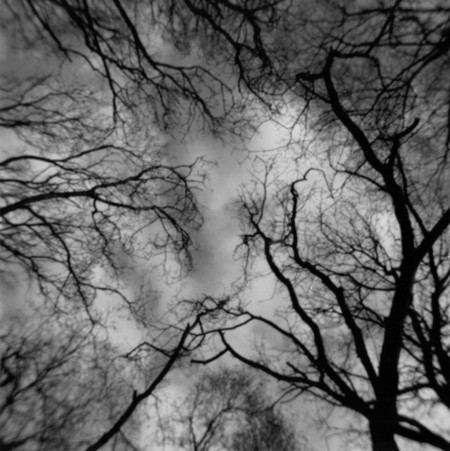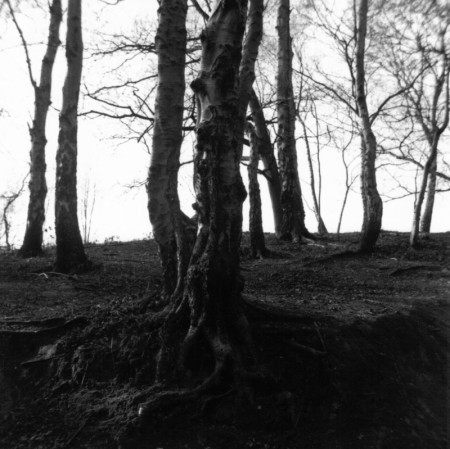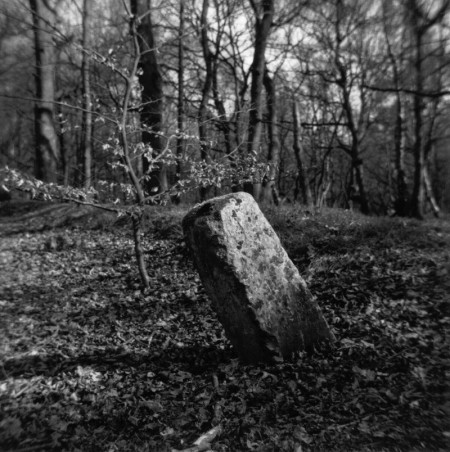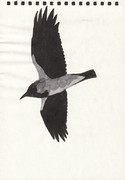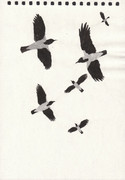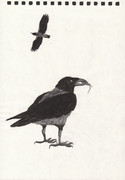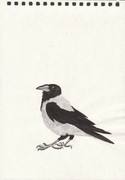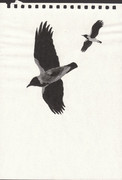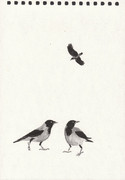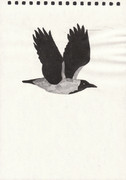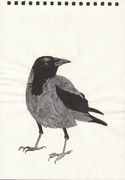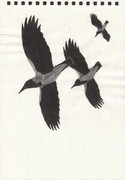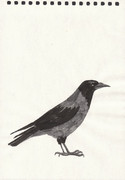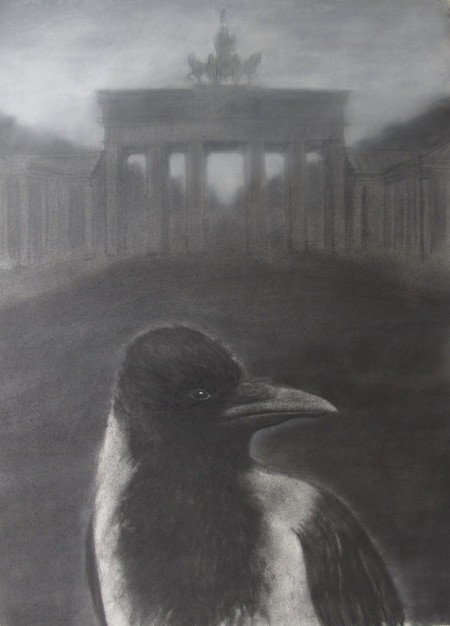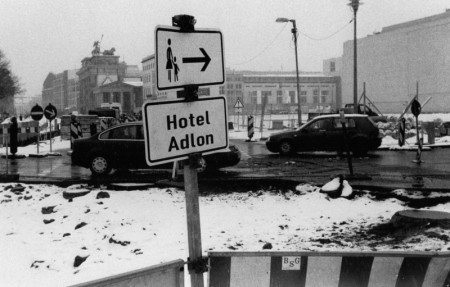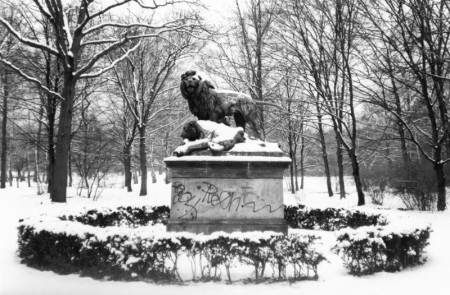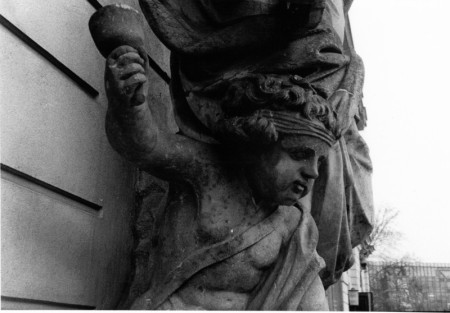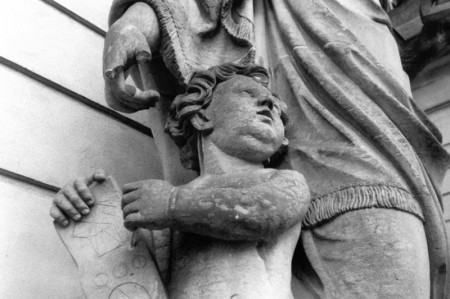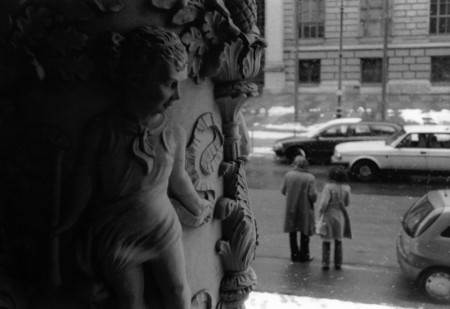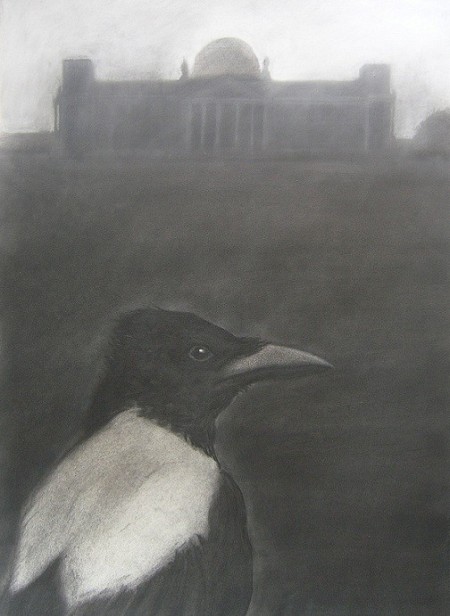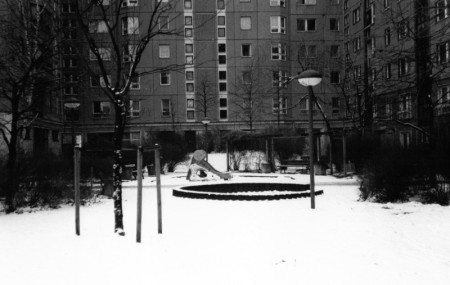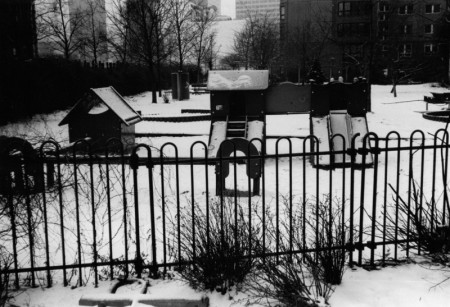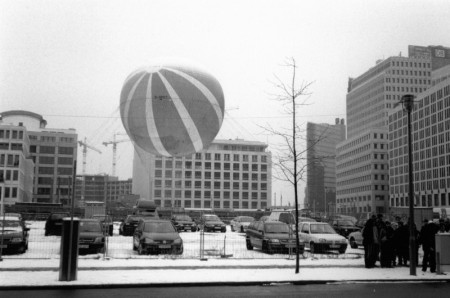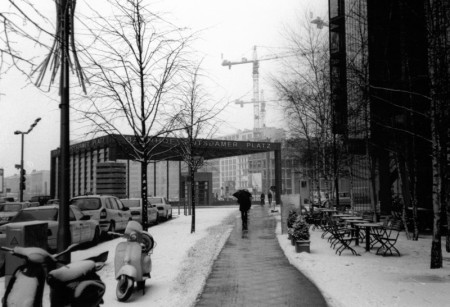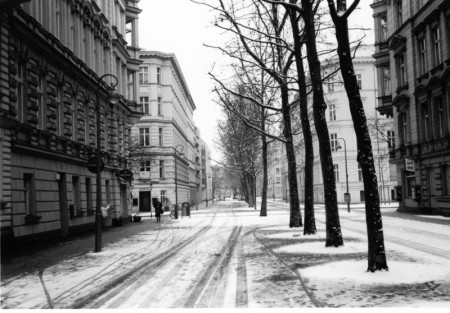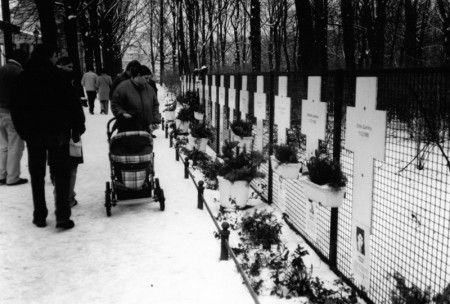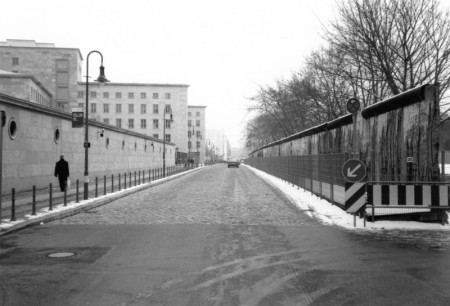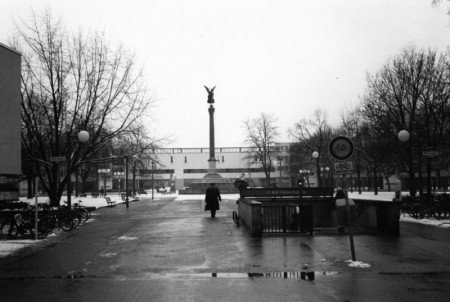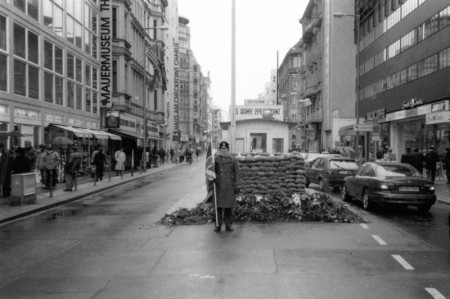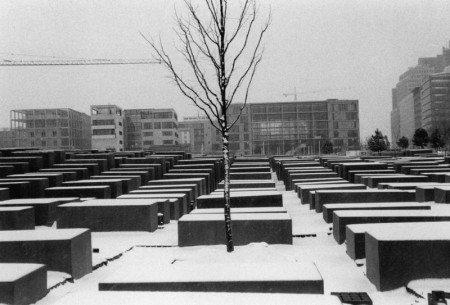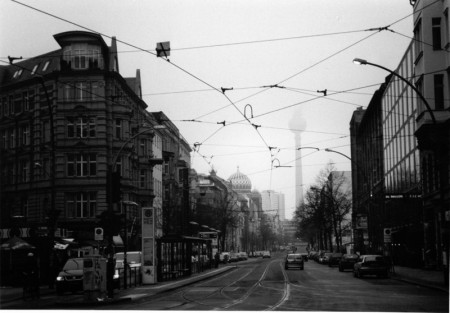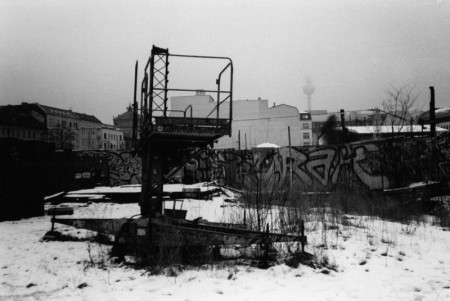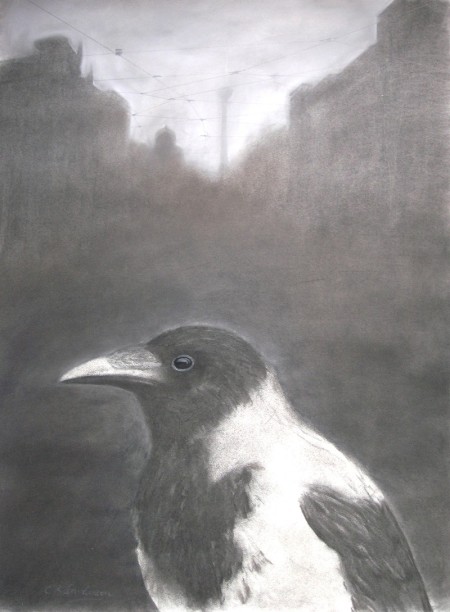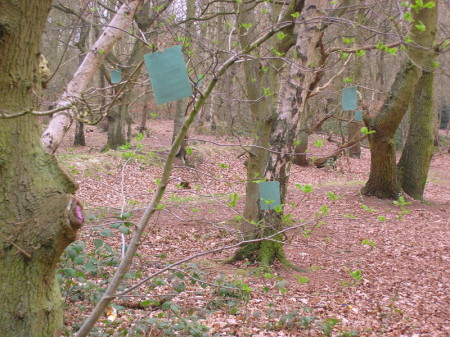
Amnesia Theatre
Text and images from an exhibition at The Assembly House, Norwich, in August 2008
This is a true story.
A woman has a dream concerning a fish.
She is standing in the middle of the road with her father – who happens to be a priest of high renown – and the fish is lying at her feet.
The fish is of a type which is known in these parts as a luce; it has twelve fins on each side, and each fin is red, as if dabbed with blood.
How did the fish get there?
How can it live in so dry a spot?
Her father tells her to take up the fish and hold it to her bosom.
She cradles the fish in her arms, rocking it to and fro, and as she strokes its head, it begins to move and grow larger and larger at an alarming rate.
It grows so fast and so large that she can no longer hold it, and it slips out of her grasp. But instead of flopping to the ground, it suddenly grows wings, takes to the air, and flies away.
It circles above them before passing through the clouds and disappearing from view.
This is a noteworthy fact.
It was laid down by the Jews in ancient times that every year they must sacrifice a Christian in some part of the world to their most high God, in scorn and contempt for Christ.
This is because it is due to Christ’s death that they have been shut out from their own country and are in exile as slaves in foreign lands.
This is a true story.
Every year, at Narbonne in Spain, where the Jews are held in high regard, lots are cast in order to determine the country where the sacrifice will take place.
In the capital city of that country, another lot is drawn to determine the town or city, and it just so happens that at this particular time the lot has fallen on the Jews of Norwich, and all the synagogues in England have signified, by letter or message, their consent that the killing should take place here.
This is a true story.
After the invasion of Britain in the spring of 1941, the German army swept away all before it, ruthlessly punishing any act of insurgency, and rounding up and executing all those it considered to be “a threat to the democratic process…”
Within days, the King and his family were fleeing to the Bahamas – heading, ironically, to the very place where his brother had been in exile after his abdication.
Edward and Mrs. Simpson returned back to London in triumph, where they were greeted by ecstatic crowds…
On August 24th, two days after the Coronation, the Fuhrer made a speech in Norwich from the balcony of the City Hall – now a run-down and dilapidated hotel – where he was flanked by Dr. Goebbles, the head of the Ministry of Popular Enlightenment and Education, and Heinrich Himmler, the Reichsfuhrer-SS, who was also responsible for the Ministry of Ancestral Inheritence.
Hitler announced to the crowd that an archaeological survey carried out by Himmler’s ministry in woodland to the north of the city had uncovered the skeleton of an adolescent boy which dated back to mediaeval times. There could be no possible doubt that these bones were those of the boy-saint William, whose cruel murder by the Jews eight hundred years before had “first opened the eyes of the world to the evil intent that was inherent in all Jewish hearts”.
It had been necessary to cleanse the stain of Judaism from the face of the earth – a project which, the Fuhrer was pleased to say, was now nearing completion.
To mark this momentous achievement in human history, the shrine of the saint – long since ruined and overgrown – was to be re-built and re-dedicated to “the most glorious accomplishment of the Third Reich…”
pages from Hooded Crow sketchbook, Berlin
Monday 21 February – Berlin
The city belongs to hooded crows; they squabble and bicker in their small murders on the pavements and roadsides, light on the walls and ledges of the buildings, then at dusk roost in the branches of the lime trees in Unter den Linden. They’re sinister and comical at the same time, a schizophrenic avatar for a schizophrenic city.
We arrived here at lunchtime after travelling through the night from Norwich. I managed to switch off on the bus down to Stanstead, and although I only had about twenty minutes doze, it saw me through until we arrived at the apartment. It’s on the seventh floor of an old East German block of flats, just over the road from the Adlon Hotel and the British Embassy – there are concrete road blocks and armed guards at either end of the street – and judging from the guidebook, only a couple of minutes walk from Hitler’s bunker.
The apartment is huge – the total area is almost the same as our house – and it’s decorated in a very minimalist fashion, with everything from the beds and wardrobes down to the last spoon coming from Ikea. This probably explains why the sofa is so bloody uncomfortable.
We went to bed - which was uncomfortable too - for a couple of hours this afternoon (we’d both been more-or-less awake for nearly thirty hours). After we got up and freshened up, we headed for the local supermarket to pick up some provisions, and making our way back to the apartment, we were serenaded by a raucous chorus of crows, who were settling down for the evening. I knocked up a reasonably palatable chilli, washed down by a reasonably palatable German red, and then we went out for a stroll by the Brandenburg Gate and Reichstag.
The streets were deserted, apart from the ever-present ghosts that haunt the city. We looked up at one of the windows of the Adlon, and saw Michael Jackson, pale-skinned and pert-nosed, standing on the balcony, dangling his baby over the edge;
and further down the street, we bumped into Diane Mitford and Oswald Mosley, walking arm-in-arm towards Goebbels’ bunker, just round the corner from our apartment, where they were about to be married in the presence of the great man himself, and with the Fuhrer’s blessing.
Meanwhile, a Russian soldier was rushing from doorway to doorway down Wilhelmstrasse, dodging a hail of bullets, and East German guards were erecting barriers of razor-wire and wood all around the western city.
And somewhere off in the distance, there was the sound of jackboots marching and glass smashing, and carried on the breeze was the smell of books burning. And as we reached the corner of the street where were staying, we tried to figure out whether the glow on the horizon was the streetlights, or the searchlights, or the Chancellery on fire.
Tuesday 22 February – Berlin
Sometimes it feels as though the city is one huge film set, and everyone who lives here or comes to visit here are really only extras in some imaginary film, with an imaginary soundtrack playing inside their heads.
The track listing for the imaginary soundtrack playing in my head at the minute is as follows:
Lisa Minnelli singing Cabaret
Most of David Bowie’s Low and Heroes albums
Beethoven’s second Piano Concerto, and his late string quartets
The Passenger by Iggy Pop
A piece of klezmer music I don’t know the title of, and can’t remember who it’s by
Berliner Requiem, and other bits and pieces by Brecht and Weill.
We left the apartment this morning and got as far as the corner of Wilhelmstrasse before S decided that she really did need her thermals after all, and dashed back to put them on. While she was gone, I thought I’d do a quick sketch of the guards and security barriers outside the British Embassy. I’d been drawing away for a couple of minutes when a couple of Polizei strode over to ask what I was up to, and could they have a look, please. As I handed the sketchbook over, S returned, looking aghast. The Polizei explained to us, in clipped English, that they’d been observing me for a while, and they needed to check us out. We could be terrorists, after all, drawing up plans to carry out an attack on the Embassy. Could they see our passports, please? And where were we staying? And what was our address in Engalnd? I didn’t think much of it – they were only doing their job, after all – but I suddenly remembered that the previous sketch in the book was one I’d done at the RSPB reserve in Minsmere, where I’d spent a lot of time getting the details right of the neighbouring nuclear power station. I was praying to God they’d just flick through the book quickly, and not assume I was (literally) drawing up a list of targets. Thankfully, they were more interested in a nude study I’d done of S, and comparing that against the photograph in her passport.
After a while they seemed satisfied that neither of us posed a threat to either country’s national security, they handed us back our passports, and bade us a good day.
S stormed off, muttering something under her breath about our next holiday being in Guantanamo Bay.
Wednesday 23 February – Berlin
History disappears; on the site of Hitler’s Bunker is a landscaped car park. One end of his Chancellery is marked by a kindergarten, and a little further along, a Chinese take-away. Potsdamerplatz is a huge leisure and retail complex. The entire city is a building site, and there are dog turds everywhere.
S is a big Christopher Isherwood fan. We walked to his apartment in Nollundorfstrasse – number 17 – and as she was posing by the door while I took her photo (whilst trying to avoid the dog turds), she struck up a conversation with a man carrying a fridge on a sack-barrow, who was in the process of moving into Isherwood’s flat. She told him she was a big Isherwood fan, and he replied that he was too, and that’s why he and his wife wanted to move there. It transpired that he was an actor, and had appeared in the stage version of Cabaret. S told him that it was one of her favourite films, but she’d never seen the stage show. Did she know it was on in Berlin at the minute? In a little theatre bar not far from here. She really ought to go.
We went to a bar and had a beer and a bite to eat, before catching the U-bahn across town to the new Jewish Museum. It’s an impressive building, based on an exploding Star of David, but it has to be said, it’s not much of a museum. There’s an awful lot about the contribution of German Jewry to mankind, but strangely enough, no mention of Charlie Marx. The main exhibition was too full of gimmicks and other interactive flim-flam, but some of the more artistically challenging pieces relating to the Holocaust were literally awesome, and moving, and thought-provoking.
We had hoped to make it back to the Brandenburg Gates for six o’clock, where there was to be an anti- Bush demonstration (he’s in Germany at the minute), but we spent longer than we really needed – and wanted – in the Museum. By the time we arrived back at our apartment, we were cold, wet and hungry, and in for the night.
As I write this, I’m looking out of the window, and it’s snowing.
Thursday 24 February – Berlin
Certain places seem to have an almost magnetic attraction for wickedness. The area between Niederkirchnerstrasse and Wilhelmstrasse has seen decades of cruelty and abuse carried out in the name of the state, dating back to the rise of the Nazis to the fall of Communism. There’s an open-air exhibition here which details this inhumanity in an informal and simple way, and tells how the courts of law were manipulated by the government to make sure that offenders were given the sentence it was deemed they deserved.
Berlin seems to be quite up front about how it remembers the past; there’s no escaping from what happened, and it’s only by confronting the memories that they can shine a light into the shadows of their history. Maybe the act of remembering helps them to forget, and to construct a collective theatre of amnesia to block out the mental traumas of Nazi-ism, and then Communism. Sometimes it goes over the top; locations of evil are turned into heritage visitor attractions, and there’s money to be made from other people’s misery. Checkpoint Charlie leaves a nasty taste in the mouth, and the motives behind some of the more ad-hoc memorials seem dubious to say the least. However, one of the most awe-inspiring and thought-provoking things we’ve seen so far has got to be the Memorial to the Murdered Jews of Europe, which is still under construction just around the corner from our apartment. It’s an overwhelming monument for an overwhelming crime.
This evening we went to see Cabaret. It was in a theatre-bar about ten minutes walk from Zoo station. The tickets were incredibly expensive – 55 euros each – and we got in only because S haggled over the price of a pair of returns, so we actually ended up paying less than half-price. The only problem was, we had to sit with the group who had returned them, and who were well out of pocket. I could sense the vibe of grumpiness emanating from the person next to me, but what the heck – it wasn’t our problem.
It was a brilliant show – dialogue in German, songs in English, and the plot quite radically altered in places.
Afterwards, we had a brief and rather unpleasant stroll around the seventh circle of hell that is Zoo Station.
Friday 25 February – Berlin
A walk around the area north of Friederichstrasse station. We picked up a few 78 rpms, most of which appear to be marching songs of the Hitler Youth, although we’ll not know for sure ‘til we get back to Blighty. We had a bite to eat in a very nice bar just round the corner from Brecht’s theatre, than spent the afternoon wandering around aimlessly, taking detours off the beaten track, and not paying too much attention to guidebook or map. We found ourselves in Oraniensburgerstrasse, past the permanently- guarded New Synagogue, and the echoes of breaking glass, and always under the ever-watchful eye of the Television Tower, which dominates the skyline with an elegant ugliness. At the end of the street is an artists’ collective. If Hitler had been a better artist, would history have taken a different course?
And in the fading light, we came to an empty Jewish cemetery that contained only one gravestone – that of Moses Mendelssohn, the Enlightenment philosopher and grandfather of the composer Felix Mendelssohn-Bartoldy.
There were no birds singing in the trees.
All things were quite silent.
Friday 22 March – Mousehold Heath
Easter’s early this year, and today doesn’t seem like Good Friday. It feels more like winter than spring, and the naked trees are still scratching their stark leafless outlines against the sullen sky. Today is also the feast day of Saint William of Norwich, who was supposedly murdered by Jews, and his body buried right here, on the edge of the Heath. It was the first case of Blood Libel ever recorded, where a race or bloodline is deemed responsible for a particular crime, and it was the spark that lit the flame that burned across Europe for hundreds of years, and is still smouldering away now.
And it all started here, in Norwich.
This being Saint William’s feast day, it seems a good time and a good place to utter a few words for the dead – all the millions of dead as a result of the wicked crimes of anti-semitism and xenophobia. I’ve printed the Kaddish – the Jewish prayer for the dead – on some sugar paper, and tied them with twine to the branches of the trees that grow on the site of Saint William’s Chapel. Now the whole place is covered with these prayer-leaves, and some of the people who are walking their dogs are looking at them and reading them, and in doing so, unwittingly saying a prayer for the dead.
Once something is spoken, it can’t be un-said.
And in a few days time, after the rain, these sugar-paper prayers will have broken down and crumbled away, and nothing will remain, except a memory.
